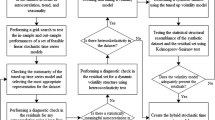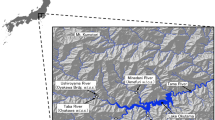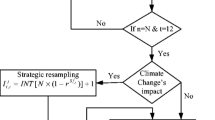Abstract
We present a detailed analysis and comparison of two time series models, i.e., ARIMA and ARIMA-GARCH, to simulate the discharge of a karst spring (Niangziguan Springs (NS) complex) in the northern China. Statistical tests for the residuals are applied to examine the reasonability of the models. Statistically, both models are reasonably good to simulate the mean value of the discharge of the NS complex. The statistical test shows that the residual discharge data have conditional time-varying variance and volatility clustering, known as heteroscedasticity of the data. Calibration test shows that the ARIMA-GARCH model gives a varying confidence interval, which can more effectively capture the heteroscedasticity of the data, comparing with a constant confidence interval in the ARIMA model. In the validation and application process, we applied two approaches to simulate the discharge data: (1) fixed models, and (2) evolving models. The confidence interval width monotonically increases in both fixed models, and the fixed ARIMA-GARCH model has faster increasing confidence interval width than the fixed ARIMA model. This suggests that the fixed time series models are only suitable for short-term prediction. However, we found that this drawback can be compensated by updating the model once new data become available. Our evolving models show more reasonable confidence interval width for both models. In addition, the application shows that the ARIMA-GARCH model is very sensitive to the data fluctuation. We also found the evolving ARIMA-GARCH model was able to return to the narrow confidence interval width once the fluctuation diminished. Hence, we conclude that the ARIMA-GARCH model is more suitable for the sequences with strong heteroscedasticity.







Similar content being viewed by others
References
Bollerslev T (1986) General autoregressive conditional heteroskedasticity. J Econ 31(3):307–327
Bollerslev T, Chou RY, Kroner KF (1992) ARCH modelling in finance: a selective review of the theory and empirical evidence. J Econ 52(1–2):5–59
Bollerslev T, Engle RF, Nelson DB (1994) ARCH Models. In: Engle, R.F. and McFadden, D. (Eds.) Handbook of Econometrics, Vol IV. North-Holland, Amsterdam, 2959–3038
Box GEP, Jenkins GM (1976) Time series analysis: forecasting and control. Holden Day, San Francisco
Charlier J, Ladouche B, Maréchal J (2015) Identifying the impact of climate and anthropic pressures on karst aquifers using wavelet analysis. J Hydrol 523:610–623
Cryer JD, Chan KS (2008) Time series analysis with applications in R. Springer, New York
Diebold FX (2004) Measuring and forecasting financial market volatilities and correlations. Norton, New York
Diebold FX, Lopez J (1995) Modelling volatility dynamics. Kluwer Academic Press Boston:427–472
Elek P, Markus L (2007) A light-tailed conditionally heteroscedastic model with applications to river flows. J Time Ser Anal 29(1):14–36
Engle RF (1982) Autoregressive conditional heteroskedasticity with estimates of the variance of United Kingdom inflation. Econometrica 50(4):987–1007
Fan J, Yao Q (2003) Nonlinear time series: nonparametric and parametric method. Springer-Verlag, New York
Fiorillo F, Petitta M, Preziosi E, Rusi S, Esposito L, Tallini M (2015) Long-term trend and fluctuations of karst spring discharge in a Mediterranean area (central-southern Italy). Environmental Earth Science 74(1):153–172
Ford DC, Williams PW (2007) Karst hydrogeology and geomorphology. Wiley, Chichester
Fuller WA (1976) Introduction to statistical time series. John Wiley and Sons, New York
Ghil M, Yiou P, Hallegatte S, Malamud BD, Naveau P, Soloviev A, Friederichs P, Keilis-Borok V, Kondrashov D, Kossobokov V, Mestre O, Nicolis C, Rust HW, Shebalin P, Vrac M, Witt A, Zaliapin I (2011) Extreme events: dynamics, statistics and prediction. Nonlinear Process Geophys 18(3):295–350
Han X, Lu R, Li Q (1993) Karst water systems: a study on big karst spring in Shanxi. Geological Publishing House, Beijing (in Chinese)
Hanel M, Buishand TA, Ferro CAT (2009) A nonstationary index flood model for precipitation extremes in transient regional climate model simulations. J Geophys Res 114:D15107. doi:10.1029/2009JD011712
Hao Y, Liu L, Li H, Li Z, Zhao J, Yeh T (2012) Investigation of karstic hydrological processes of Niangziguan Springs (North China) using wavelet analyses. Hydrol Process 26(20):3062–3069. doi:10.1002/hyp.826
Hao Y, Cao B, Chen X, Yin J, Sun R, Yeh T (2013) A piecewise grey system model for study the effects of anthropogenic activities on karst hydrological processes. Water Resour Manag 27(5):1207–1220
Hipel KW, McLeod AI (1994) Time series modelling of water resources and environmental systems. Elsvier, Amsterdam
Huo X, Liu Z, Duan Q, Hao P, Zhang Y, Hao Y, Zhan H (2016) Linkages between large-scale climate patterns and karst spring discharge in northern China. J Hydrometeorol 17(2):713–724
Jimenez-Martinez J, Smith M, Pope D (2016) Prediction of groundwater-induced flooding in a chalk aquifer for future climate change scenarios. Hydrol Process 30(4):573–587
Khaliq MN, Ouarda TBMJ, Ondo JC, Gachon P, Bobe’e B (2006) Frequency analysis of a sequence of dependent and/or non-stationary hydro-meteorological observations: a review. J Hydrol 329(3–4): 534–552
Kharin VV, Zwiers FW (2005) Estimating extremes in transient climate change simulations. J Clim 18(8):1156–1173
Laux P, Vogl S, Qiu W, Knoche HR, Kunstmann H (2011) Copula-based statistical refinement of precipitation in RCM simulations over complex terrain. Hydrol Earth Syst Sci 15:2401–2419
Leibundgut C (1998) Vulnerability of karst aquifers. IAHS 247:45–60
Liang Y, Gao H, Zhang J, Huo J, Wang T (2005) Preliminary quantitative analysis on the causes of discharge attenuation in Niangziguan spring. Carsologica Sinica 24(3):227–231 (in Chinese)
Ling S, Li WK (1997) On fractionally integrated autoregressive moving-average time series models with conditional heteroskedasticity. J Am Stat Assoc 92(439):1184–1194
Ling S, Li WK (1998) Limiting distributions of maximum likelihood estimators for unstable ARMA models with GARCH errors. Ann Stat 26(1):84–125
Ling S, McAleer M (2003) Asymptotic theory for a vector ARMA-GARCH model. Econometric Theory 19(2):280–310
Ljung GM, Box GEP (1978) On a measure of lack of fit in time series models. Biometrika 65(2):297–303
McLeod AI, Li WK (1983) Diagnostic checking ARMA time series models using squared residual autocorrelations. J Time Ser Anal 4(4):269–273
Milly PCD, Betancourt J, Falkenmark M, Hirsch RM, Kundzewicz ZW, Lettenmaier DP, Stouffer RJ (2008) Stationarity is dead: whither water management. Science 319(1):573–574
Modarres R, Ouarda TBMJ (2013) Modelling heteroscedasticty of streamflow times series. Hydrol Sci J 58(1):54–64
Porporato A, Ridolfi L (1998) Influence of weak trends on exceedance probability. Stochastic Hydraulics Hydrology 12(1):1–14
Schiperski F, Zirlewagen J, Hillebrand O, Nödler K, Licha T, Scheytt T (2015) Relationship between organic micropollutants and hydro-sedimentary processes at a karst spring in south-west Germany. Sci Total Environ 532:360–367
Sutton J, Screaton E, Martin J (2015) Insights on surface-water/groundwater exchange in the upper Floridan aquifer, north-central Florida (USA), from streamflow data and numerical modeling. Hydrogeol J 23(2):305–317
Villarini G, Smith JA, Napolitano F (2010) Nonstationary modeling of a long record of rainfall and temperature over Rome. Adv Water Resour 33(10):1256–1267
Visser H, Petersen AC (2012) Inferences on weather extremes and weather-related disasters: a review of statistical methods. Clim Past 8(1):265–286
Wang XL, Zwiers FW, Swail VR (2004) North Atlantic Ocean wave climate change scenarios for the twenty-first century. J Clim 17(12):2368–2383
Wang W, Van Gelder PHAJM, Vrijling JK, Ma J (2005) Testing and modelling autoregressive conditional heteroskedasticity of streamflow processes. Nonlinear Process Geophys 12(1):55–66
Wang H, Gao X, Qian L, Yu S (2012) Uncertainty analysis of hydrological processes based on ARMA-GARCH model. SCIENCE CHINA Technol Sci 55(8):2321–2331
Wang HR, Wang C, Lin X, Kang J (2014) An improved ARIMA model for precipitation simulations. Nonlinear Process Geophys 21(6):1159–1168
Whittle, P. (1951). Hypothesis Testing in Time Series Analysis. Uppsala: Almqvist and Wiksells Boktryckeri.
Wilks SS (1938) The large-sample distribution of the likelihood ratio for testing composite hypotheses. Ann Math Stat 9:60–62
Zhang Q, Wang BD, He B, Peng Y, Ren ML (2011) Singular Spectrum analysis and ARIMA hybrid model for annual runoff forecasting. Water Resour Manag 25(11):2683–2703
Acknowledgments
This work is partially supported by the National Natural Science Foundation of China under the grant numbers 41402210, 41272245, 40972165, 40572150, 41471001 and 11601244 as well as the China Scholarship Council under the grant number 201508120014.
Author information
Authors and Affiliations
Corresponding author
Rights and permissions
About this article
Cite this article
Liu, Y., Wang, B., Zhan, H. et al. Simulation of Nonstationary Spring Discharge Using Time Series Models. Water Resour Manage 31, 4875–4890 (2017). https://doi.org/10.1007/s11269-017-1783-6
Received:
Accepted:
Published:
Issue Date:
DOI: https://doi.org/10.1007/s11269-017-1783-6




